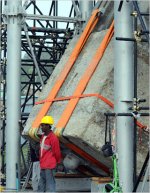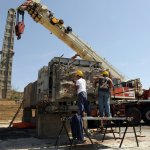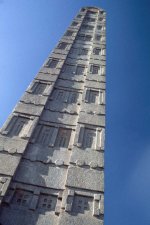Per the PTB: The Obelisk of Axum is a 4th-century AD, 24-metre-tall (79-feet) obelisk, weighing 160 tonnes, in the city of Axum in Ethiopia. The obelisk ends in a semi-circular top part, which used to be enclosed by metal frames.
The Obelisk of Axum is intricately carved to represent a nine-story Axumite building. At the base are two false doors, carved to look like the wooden entryways into an Axumite home. The detail on these doors is incredible, even to the point of false locks being carved into them. The architectural illusion continues as we work up the monolith. Each 'story' of the building appears to have a frame, structural supports, and windows, all of which are only carved outlines. At the top is a rounded peak that once was enclosed in a metal frame. It was likely used to hold some sort of symbolic image or icon. Overall, this impressive structure gives the impression of a massive building, giving us a strong idea about what the architecture of Axum would have looked like.

The stelae were probably carved and erected during the 4th century CE by subjects of the Kingdom of Aksum, an ancient Ethiopian civilization.
In a 1947 UN agreement, Italy agreed to return the stele to Ethiopia. Little action was taken to return the stele for more than 50 years, partly as a consequence of the considerable technical difficulties related to its transportation.
The first steps in dismantling the structure (in Italy) were taken in November 2003. The intent was to ship the stele back to Ethiopia in March 2004, but the repatriation project encountered a series of obstacles:

KD: Here we have a few close ups to consider.
I only have two versions of what these were made for. I do not believe in either one of my own versions, but what else could it be?

Wondering if the stuff is somehow related to what you can see in the video below.
You gotta love our pseudo-historians. They feed us this “obelisk” BS instead of saying:
KD: Any opinions on all of this non-sense?
The Obelisk of Axum is intricately carved to represent a nine-story Axumite building. At the base are two false doors, carved to look like the wooden entryways into an Axumite home. The detail on these doors is incredible, even to the point of false locks being carved into them. The architectural illusion continues as we work up the monolith. Each 'story' of the building appears to have a frame, structural supports, and windows, all of which are only carved outlines. At the top is a rounded peak that once was enclosed in a metal frame. It was likely used to hold some sort of symbolic image or icon. Overall, this impressive structure gives the impression of a massive building, giving us a strong idea about what the architecture of Axum would have looked like.
- Erection of stelae in Axum was a very old practice probably borrowed from the Kushitic kingdom of Meroe.
- Their function is supposed to be that of "markers" for underground burial chambers.
- The largest of the grave markers were for royal burial chambers and were decorated with multi-story false windows and false doors, while lesser nobility would have smaller, less decorated ones.
- The last stele erected in Axum was probably the so-called King Ezana's Stele, in the 4th century CE.
In a 1947 UN agreement, Italy agreed to return the stele to Ethiopia. Little action was taken to return the stele for more than 50 years, partly as a consequence of the considerable technical difficulties related to its transportation.
The first steps in dismantling the structure (in Italy) were taken in November 2003. The intent was to ship the stele back to Ethiopia in March 2004, but the repatriation project encountered a series of obstacles:
- The runway at Axum Airport was considered too short for a cargo plane carrying even one of the thirds into which the stele had been cut.
- The roads and bridges between Addis Ababa and Axum were thought to be not up to the task of road transport.
- The access through the nearby Eritrean port of Massawa - which was how the stele originally left Africa - was impossible due to the strained state of relations between Eritrea and Ethiopia.
- The runway at Axum airport was then upgraded specially to facilitate the return of the stele.
- It was the largest and heaviest piece of air freight ever carried.
- All pieces were transported back to Ethiopia in 2005.
- By March 2007 the foundation had been poured for the re-erection of the stele near King Ezana's Stele, structurally consolidated in this occasion.
- Reassembly began in June 2008, and the monument was re-erected in its original home and unveiled on 4 September 2008.
- How did they even get this thing to Italy in 1937, and why to go through all the difficulties related to moving this monster?
KD: Here we have a few close ups to consider.
I only have two versions of what these were made for. I do not believe in either one of my own versions, but what else could it be?
- 1. We are witnessing some cargo cult products.
- 2. These “obelisks” (and there are quite a few left) served as skyscraper models for some humongous city mockups.
Wondering if the stuff is somehow related to what you can see in the video below.
You gotta love our pseudo-historians. They feed us this “obelisk” BS instead of saying:
- We have no clue why Ethiopians were building nine story, 80 foot tall high rise building models 1,600 years ago in the 4th century AD.
KD: Any opinions on all of this non-sense?







